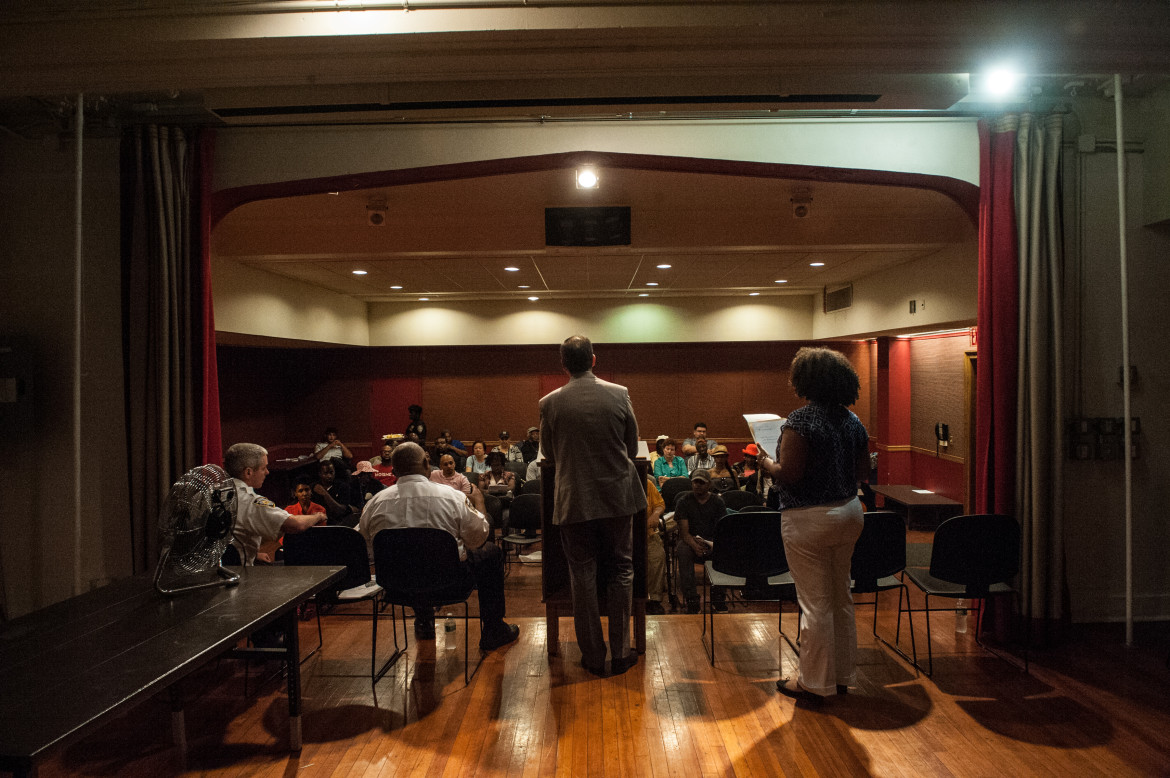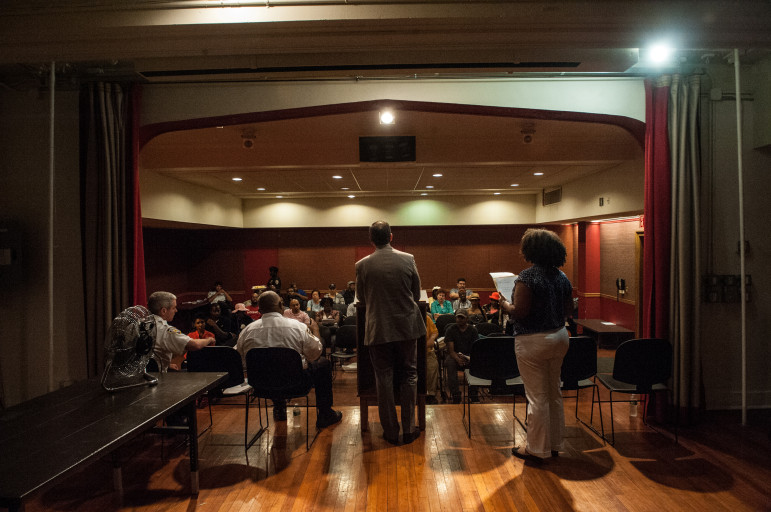
Robert Stolarik / JJIE
Members of the NYPD, Manhattan District Attorney's Office and members of the community attend a Police Community Council meeting at the George Bruce Branch Library in Harlem Tuesday, the first since the largest raid in NYPD's history.
NEW YORK — Phase I was swift, comprehensive and over in a couple of hours. It was executed with military efficiency and resulted in dozens of arrests and 103 charges. And as a meeting last night showed, that means the launch of Phase II, which remains a work in progress, will involve lots of “partnering,” patience and the promise of more meetings in airless rooms, outfitted with drinks and an assortment of snacks.
During the first 26th Precinct Community Council meeting since the June 3 raid of the Manhattanville and Grant Houses — the largest in the police department’s history — in which hundreds of heavily armed officers swept through the projects, Deputy Inspector Steven Griffith, the commander of the 26th Precinct, and Reynaldo Cabrera, who heads up the crime strategies unit for the Manhattan District Attorney’s office, revealed details Tuesday night about the raid and laid out for the precinct’s bewildered residents law enforcement’s plan in the wake of the arrests.
 “So this back and forth, this rivalry, between the three groups just took on a life of its own and it became very dangerous. We had 50 shootings attributed just to this beef,” Griffith said to a packed house. “And that means we know that every time a bullet is pulled that’s a potential lost life. We had two people lose their lives — young people — and we had 24 people shot. So we’re talking about some serious crimes, we’re not talking about fighting with fists and throwing rocks.”
“So this back and forth, this rivalry, between the three groups just took on a life of its own and it became very dangerous. We had 50 shootings attributed just to this beef,” Griffith said to a packed house. “And that means we know that every time a bullet is pulled that’s a potential lost life. We had two people lose their lives — young people — and we had 24 people shot. So we’re talking about some serious crimes, we’re not talking about fighting with fists and throwing rocks.”
But, Griffith added, the chaos, and its abrupt end in the wake of the raid, is an opportunity to start over.
“It was very important that we removed these people from the street and hopefully, after the ADA’s clear some things up some of these people who were really bad are going to spend some time in jail and allow the community to heal and to turn a corner,” he said. “We’re going to hopefully reach out to some of these people, and not just the kids — remember these kids are coming from families and we have to get into some of these homes and we have to see what’s going on. And we have to help some of these parents to help to turn not just the kid’s fortunes around and sometimes the homes.”
Turmoil in Harlem: read more JJIE coverage
Griffith and Cabrera joined others on a small stage in the hot, stuffy basement of the George Bruce Branch Library just blocks away from where the raid took place. A table in the back of the room had bottles of soda and water and a variety of snacks, cookies and chips. The room was full and many in attendance did not challenge what Griffith and Cabrera repeatedly referred to as “the takedown.”
The audience members filled the 40 or so folding chairs and listened quietly as Griffith and Cabrera took turns talking about what led to the raid, its execution and what both the district attorney’s office and the NYPD is planning to do to change the conditions in the houses so another raid isn’t executed a few years from now. After a moment of silence to start the meeting, everyone stood to recite the Pledge of Allegiance even though there was no flag. They agreed to “pretend” there was one and all recited the words staring at a blank space on the stage.
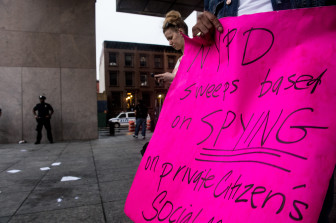
Robert Stolarik / JJIE.org
Residents of West Harlem staged a rally outside The Adam Clayton Powell Jr. State office building June 13 protesting police conduct during a gang raid at the Manhattanville Houses and Grant Houses earlier this month.
The atmosphere Tuesday night was a sharp departure from an impassioned and angry rally at the Adam Clayton Powell Jr. State Office Building a week and a half before when protesters shouted slogans and jabbed signs in the air that read: “NYPD Sweeps Based on Spying On Private Citizens' Social Media!” Protesters gathered to draw attention to what they said was a military style raid in which officers used excessive force, including handcuffing girls in underwear who were not part of the indictment, and scaring toddlers so badly that they peed themselves.
At the rally, a mix of residents and anti-police brutality and political organizations directed their discontent at police officers who glowered back at them in a torrential rain. A contingent broke off from the pack and led an unplanned march down the street to a nearby police precinct, while security struggled to keep protesters confined to a section of the plaza.
The two events — the enraged protesters and the engaged residents at the council meeting — put in sharp relief the rivalrous response to the massive gang raid. Some residents are outraged that what they see as a social problem was solved by guns and warrants. Others expressed hope that the arrests would end the wave of violence that had swept over the area in the wake of 18-year-old Tayshana “Chicken” Murphy’s murder.
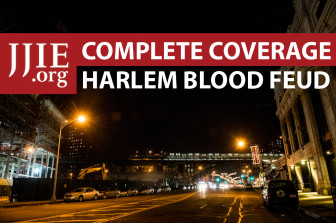 But both sides are asking what the city plans to do now that the raid is over.
But both sides are asking what the city plans to do now that the raid is over.
Derrick Haynes, along with Taylonn Murphy, the father of the girl whose murder is at the heart of the district attorney’s case, and Arnita Brockington the mother of Murphy’s killer, worked to stem the violence between the houses. Haynes said he understood that something needed to be done. He said although many people have complaints with it, law enforcement needed to do something to respond to the outbreak of shootings and beatings. But he challenged Griffith and Cabrera, and said that the problem that led to the violence is still being ignored.
“When I go to these meetings we never talk about how we got to this point,” Haynes said. “We have to talk about how we got here. This is a result of the system breaking down — we had to do the raid, crime was up there were shootings, we had to do something. But here we are again and we’re not making the kids a priority.”
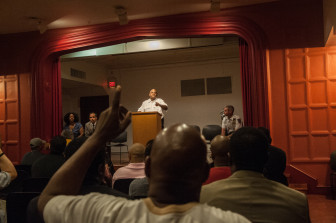
Robert Stolarik / JJIE
Derrick Haynes raises his hand during the community meeting Tuesday as he asks a question of Deputy Inspector Griffith.
Griffith spoke directly to Haynes as he responded to his concern.
“Listen to me Derrick, you are probably one of the first persons I met when I came to the command,” Griffith said. “Derrick has grown up in Manhattanville and he works with juvenile offenders so he has a big history. Now listen D, you are speaking the gospel. You know as a police commander there are certain things I can do but I need people in this audience — we need to rally people around to get some of these community centers open, because every center that we can open, every place that we can have to get these kids open are important.”
Cabrera also responded to Haynes. He talked about how the Manhattanville Community Center is going to be open to children and that the district attorney’s office is going to host its Saturday Night Lights basketball program there on July 18. He cited the comments made by the highest-ranking NYPD uniformed officer to assuage Haynes’s apprehension.
“I like how he explained it, a lot of times with law enforcement it’s easy to say, ‘Hey we did our jobs; we move on,’” he said. “But the way he looks at it, and I think we should all follow his advice, is that it’s a new beginning. Here’s an opportunity to start over and to get back to Mr. Haynes’ point how do we address the issues that got us to this point because we don’t want to be back here four years from now having the same speech.”
Sabine Franklin, a representative from City Councilman Mark Levine’s office, who represents the district where the raid occurred, said money had been set aside to fight the city’s gang problem. But, she added, money has also been set aside to open New York City Housing Authority community centers, including the ones that serve the residents of the Manhattanville and Grant Houses.
“This goes back to Deputy Inspector Griffith’s statement about what we need to do for the community going forward in terms of preventing crime especially in young people,” she said. “So again our city council is here as a resource to help provide some of these services as well as partnering with the NYPD.”
Griffith talked about an “uptick” in violent crime in the wake of the shooting murder of Tayshana “Chicken” Murphy and how what he described as three gangs affiliated with the houses engaged in shootings, even up to the night before the raid.
“These three groups were back and forth for a couple of years and this led to numerous shootings, two homicides, and just if you lived in this community — an uneasiness,” he said. “So at a certain point there was something that needed to be done. So we did Phase I.”
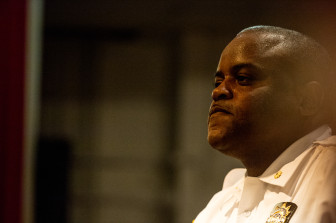
Robert Stolarik / JJIE
Griffith listens to community members at the meeting Tuesday in Harlem.
Griffith said now that the department has executed the enforcement end with the raid, the department, along with the district attorney’s office, has entered into Phase II — a series of partnerships with community members with ideas for preventing the gang problem from taking root again.
“We removed some people that we believed were bad actors and hopefully they won’t be back here for awhile,” Griffith said. “What we do now is we have to invest in the community and we have to make sure that the young kids that are left, we won’t have the same situation in a couple of years.”
Cabrera called this post-raid plan the Stakeholders Group — a hodgepodge mix of schools, churches, businesses and community residents with ideas for creating an environment that doesn’t lead the generation of children left behind at both houses to follow in the what he and Griffith described as the gang members’ path.
“Now, other people were rounded up and, as I’m sure as most of you know, when the takedown happened there was a lot of community outpouring about that,” Cabrera said, acknowledging the outpouring of frustration from some residents. “But what’s going to happen next is this: The office does have a plan and we’re working closely with the police department. We have short-term plans and we have long term plans. One of the things we did on the east side is creating what we are calling a stakeholders group — that stakeholders group are the folks we believe we can partner with who can provide the resources to sustain the ground so to speak.”
He said law enforcement needs community ideas.
“We’re not experts in the social services,” he said. “We also need folks like yourself to partner up.”
Although they talked at length about stakeholders and partnering, both Cabrera and Griffith reassured the residents in attendance that Phase II will not slow down their respective office’s missions.
“Obviously there are going to be some folks who just do what they’re going to do,” he said. Law enforcement is going to do what law enforcement has to do to limit these folks from hurting you. That’s the main goal of law enforcement is to protect you and to keep the community safe.”
Griffith agreed.
“We’re still an enforcement agency and anyone that we see committing crimes we’re going to lock them up,” Griffith said. “Part of this sort of maintenance plan that we’re doing is were out there fielding information looking to see who’s trying to step into that role because there is a void right now so someones trying to step into that role and commit criminal acts we’re going to lock them up. It’s just that simple.”
Financial supporters of The JJIE may be quoted or mentioned in our stories. They may also be the subjects of our stories.
